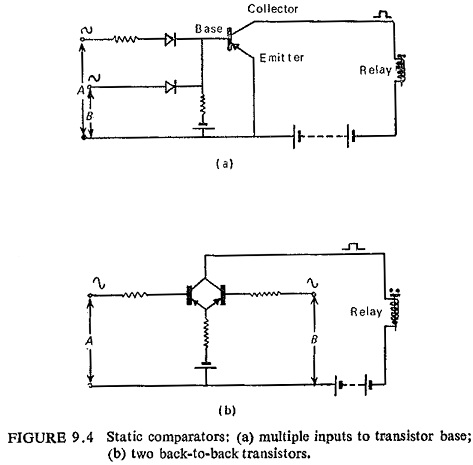Transistor Relays:
These are the most widely accepted type of static relays, so much so that when we say static relays, we can safely infer transistor relays only. The transistor which acts like an electronic valve can overcome most of the limitations posed by the electronic valves and thus has made possible to develop the electronic relays more commonly known as static relays.
The characteristics of modern transistors are such that they can replace the functional elements which are used in electromechanical relay to give necessary characteristics.
The technical features particularly suited to the design of functional units include amplifying and switching characteristics, sensitivity and high speed. Experience has shown that transistor circuits can not only perform the essential functions of a relay such as summation, comparison of inputs and integrating them, but they also provide necessary flexibility to suit the various relay requirements.
Two basic arrangements of relays based on transistor comparators are shown in Fig. (9.4). In either of these circuits, current of constant magnitude flows in the collector circuit only when the input a.c. quantities are simultaneously negative; a relay in the collector circuit will pick up when the overlap angle exceeds a certain value, i.e. when the mean d.c. level in the collector circuit exceeds the relay pickup as a result of phase coincidence.
The advantages of Transistor Relays may be enumerated as follows :
- Quick response, long life, high resistance to shock and vibration.
- Quick reset action—a high reset value and absence of overshoot is easily achieved because of the absence of mechanical inertia and thermal storage
- No bearing friction or contact troubles (no corrosion, bouncing or wear), so minimum maintenance required.
- Ease of providing amplification enables greater sensitivity to be obtained.
- The basic building blocks of semiconductor circuitry permit greater degree of sophistication in the shaping of operating characteristics, enabling the practical realization of relays with threshold characteristics more closely approaching the ideal requirements.
- The low energy levels required in the, measuring circuits permit miniaturization and minimize current transformer inaccuracies.
- Use of printed (or integrated circuits) to avoid wiring errors and to facilitate rationalization of batch production.
Static relays employing transistors have their limitations which are:
- Variation of characteristics with temperature and age.
- Dependence of reliability on a large number of small components and their electrical connections.
- Low short time overload capacity compared with electromagnetic relays.
- It has now become possible to compensate for all these factors.
